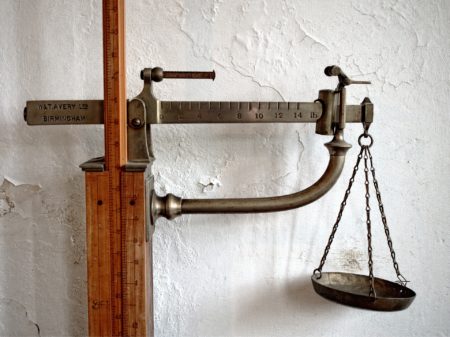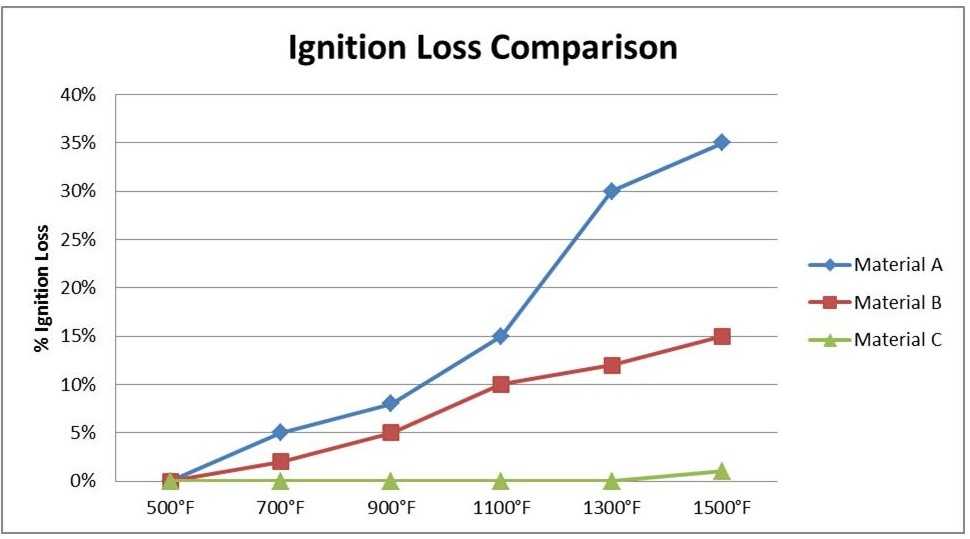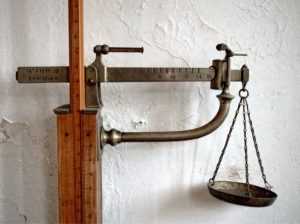 Welcome to the fourth installment of our “Why Do I Care” series. Every so often, we’ll blog about some of the questions people new to the gasket industry may be looking for more information about. Click the links below to read the first three installments:
Welcome to the fourth installment of our “Why Do I Care” series. Every so often, we’ll blog about some of the questions people new to the gasket industry may be looking for more information about. Click the links below to read the first three installments:
- What Is Compressibility & Recovery, and Why Do I Care?
- What Is Bolt Load, and Why Do I Care?
- What Is Creep Relaxation, and Why Do I Care?
This week we’re going to talk about ignition loss in gaskets and gasket material. It is a fairly simple concept, but it can be a critical property if you’re dealing with heat that is potentially higher than your gasket material can handle. Ignition loss is the amount of weight your gasket loses under various temperature conditions. All materials have some loss when exposed to heat, but there are some materials that are better than others in high temperatures. Looking at the ignition loss values and comparing them to other materials will start you down the path to selecting the right material for your application.
Ignition Loss
Ignition loss is a test that is performed on the facing materials used in your gasket construction. It is also only done on materials with a temperature rating high enough to survive the hour-long test (graphite at 670°C/1238°F and non-asbestos facings at 815°C/1500°F). If your applications don’t see this kind of heat, ignition loss isn’t a concern for you.
What kind of results do you want to see from this test? Most specifications list a maximum percentage of loss at a certain temperature. The lower the percentage, the better. If you know how hot your application runs, you’re better able to educate yourself on the materials and their capabilities by comparing the ignition loss percentages.
Real-Life Application
 Take a look at the fictional test results for the three materials shown below. We have put together a likely representation of three materials and how much weight they lose at various temperatures. As you can see, they clearly withstand different levels of heat.
Take a look at the fictional test results for the three materials shown below. We have put together a likely representation of three materials and how much weight they lose at various temperatures. As you can see, they clearly withstand different levels of heat.
Material C is by far the best in terms of ignition loss. Even at 1500°F, there is still only a 1% loss. This material was designed to survive in extreme temperatures and it does just that. You may be asking why don’t you just use that for everything? Well, price is probably the largest factor. To get that kind of performance, you will pay a premium price. You (or your customer) probably won’t want to pay a premium price unless you need that performance capability. Performance and price have a direct correlation, and most people don’t want to pay for more performance than they need (and a good gasket material supplier won’t try to up-sell you with a material that you don’t really need).
Now, look at Materials A & B. Until the temperature exceeds 1100°F, they are relatively the same. So, if you had an application that peaked around 1100°F, you would probably start with considering both of them. Next, you would take a closer look at the other test properties to zero in on what you want to test. However, if you later learn that your application is actually closer to 1300°F, then Material B will likely be the material you may want to start considering.
Using The Data
Ignition loss isn’t the only factor that you should be looking at when deciding on which gasket material to select, but it is an important one to look at first. Removing materials from consideration that probably will not survive the heat is an important first step.
Do you consider ignition loss to be an important property? If you are interested in subscribing to Sealed-In’s blog posts, email sales@mtigasket.com.

Welcome to the fourth installment of our “Why Do I Care” series. Every so often, we’ll blog about some of the questions people new to the gasket industry may be looking for more information about. Click the links below to read the first three installments:
- What Is Compressibility & Recovery, and Why Do I Care?
- What Is Bolt Load, and Why Do I Care?
- What Is Creep Relaxation, and Why Do I Care?
This week we’re going to talk about ignition loss in gaskets and gasket material. It is a fairly simple concept, but it can be a critical property if you’re dealing with heat that is potentially higher than your gasket material can handle. Ignition loss is the amount of weight your gasket loses under various temperature conditions. All materials have some loss when exposed to heat, but there are some materials that are better than others in high temperatures. Looking at the ignition loss values and comparing them to other materials will start you down the path to selecting the right material for your application.
Ignition Loss
Ignition loss is a test that is performed on the facing materials used in your gasket construction. It is also only done on materials with a temperature rating high enough to survive the hour-long test (graphite at 670°C/1238°F and non-asbestos facings at 815°C/1500°F). If your applications don’t see this kind of heat, ignition loss isn’t a concern for you.
What kind of results do you want to see from this test? Most specifications list a maximum percentage of loss at a certain temperature. The lower the percentage, the better. If you know how hot your application runs, you’re better able to educate yourself on the materials and their capabilities by comparing the ignition loss percentages.
Real-Life Application
Take a look at the fictional test results for the three materials shown below. We have put together a likely representation of three materials and how much weight they lose at various temperatures. As you can see, they clearly withstand different levels of heat.
Material C is by far the best in terms of ignition loss. Even at 1500°F, there is still only a 1% loss. This material was designed to survive in extreme temperatures and it does just that. You may be asking why don’t you just use that for everything? Well, price is probably the largest factor. To get that kind of performance, you will pay a premium price. You (or your customer) probably won’t want to pay a premium price unless you need that performance capability. Performance and price have a direct correlation, and most people don’t want to pay for more performance than they need (and a good gasket material supplier won’t try to up-sell you with a material that you don’t really need).
Now, look at Materials A & B. Until the temperature exceeds 1100°F, they are relatively the same. So, if you had an application that peaked around 1100°F, you would probably start with considering both of them. Next, you would take a closer look at the other test properties to zero in on what you want to test. However, if you later learn that your application is actually closer to 1300°F, then Material B will likely be the material you may want to start considering.
Using The Data
Ignition loss isn’t the only factor that you should be looking at when deciding on which gasket material to select, but it is an important one to look at first. Removing materials from consideration that probably will not survive the heat is an important first step.
Do you consider ignition loss to be an important property? If you are interested in subscribing to Sealed-In’s blog posts, email sales@mtigasket.com.

Welcome to the fourth installment of our “Why Do I Care” series. Every so often, we’ll blog about some of the questions people new to the gasket industry may be looking for more information about. Click the links below to read the first three installments:
- What Is Compressibility & Recovery, and Why Do I Care?
- What Is Bolt Load, and Why Do I Care?
- What Is Creep Relaxation, and Why Do I Care?
This week we’re going to talk about ignition loss in gaskets and gasket material. It is a fairly simple concept, but it can be a critical property if you’re dealing with heat that is potentially higher than your gasket material can handle. Ignition loss is the amount of weight your gasket loses under various temperature conditions. All materials have some loss when exposed to heat, but there are some materials that are better than others in high temperatures. Looking at the ignition loss values and comparing them to other materials will start you down the path to selecting the right material for your application.
Ignition Loss
Ignition loss is a test that is performed on the facing materials used in your gasket construction. It is also only done on materials with a temperature rating high enough to survive the hour-long test (graphite at 670°C/1238°F and non-asbestos facings at 815°C/1500°F). If your applications don’t see this kind of heat, ignition loss isn’t a concern for you.
What kind of results do you want to see from this test? Most specifications list a maximum percentage of loss at a certain temperature. The lower the percentage, the better. If you know how hot your application runs, you’re better able to educate yourself on the materials and their capabilities by comparing the ignition loss percentages.
Real-Life Application
Take a look at the fictional test results for the three materials shown below. We have put together a likely representation of three materials and how much weight they lose at various temperatures. As you can see, they clearly withstand different levels of heat.
Material C is by far the best in terms of ignition loss. Even at 1500°F, there is still only a 1% loss. This material was designed to survive in extreme temperatures and it does just that. You may be asking why don’t you just use that for everything? Well, price is probably the largest factor. To get that kind of performance, you will pay a premium price. You (or your customer) probably won’t want to pay a premium price unless you need that performance capability. Performance and price have a direct correlation, and most people don’t want to pay for more performance than they need (and a good gasket material supplier won’t try to up-sell you with a material that you don’t really need).
Now, look at Materials A & B. Until the temperature exceeds 1100°F, they are relatively the same. So, if you had an application that peaked around 1100°F, you would probably start with considering both of them. Next, you would take a closer look at the other test properties to zero in on what you want to test. However, if you later learn that your application is actually closer to 1300°F, then Material B will likely be the material you may want to start considering.
Using The Data
Ignition loss isn’t the only factor that you should be looking at when deciding on which gasket material to select, but it is an important one to look at first. Removing materials from consideration that probably will not survive the heat is an important first step.
Do you consider ignition loss to be an important property? If you are interested in subscribing to Sealed-In’s blog posts, email sales@mtigasket.com.
